
Its History, Legends and Lore / by Dorothy V. Corson

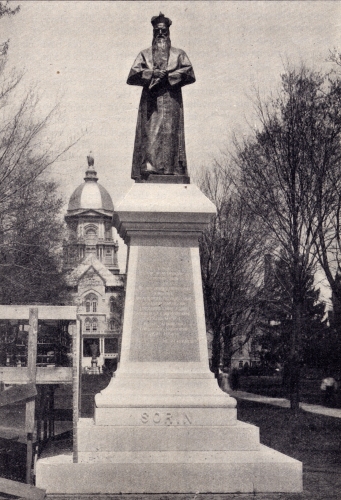
Father John W. Cavanaugh had been president hardly a year in 1906 when there occurred at Notre Dame a double celebration in which the names of Sorin and Badin were honored. For a year considerable efforts had been made to procure a heroic statue of Father Sorin which was to be placed at the entrance of the old quadrangle in memory of Very Reverend Edward Sorin, C.S.C.
The Notre Dame Scholastic published a description of the pedestal and statue. “The pedestal of the Founders Monument is made of the best Vermont granite and is declared by everyone to be a splendid specimen of the stone worker’s art. The statue, which was modeled by the celebrated sculptor, Ernesto Biondi, will attract more than ordinary attention. It represents our Founder as he appeared, in years gone by, to greet students and friends on their arrival at Notre Dame.” It was to cost $25,000. -- Notre Dame Scholastic April 21, 1906, page 442.
Following are excerpts from the sermon preached by the Most Rev. John J. Keane, D.D. Archbishop of Dubuque on the occasion of the unveiling of the Sorin Monument on May 3, 1906, the Feast of the Invention of the Holy Cross:
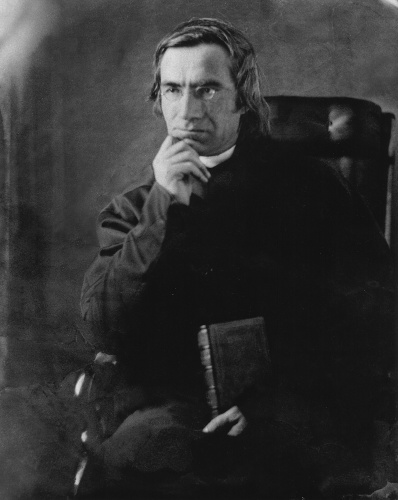
The thirteen years that have elapsed since Father Sorin’s death, far from dimming our remembrance of him, have but served to set forth in clearer light the splendid character which during the fifty-two years of his priestly life and labors in America rendered him colossal among his fellowmen. It would be an injustice, not only to him but to the Providence that made him what he was, to permit such a life-example to pass into oblivion. It is in the spirit, therefore, of dutifulness toward Providence, as well as toward Father Sorin, and those who are thankful to be his disciples, that we today dedicate this statue to his memory.
Providence gave them as the cradle of their Order the village of Holy Cross, a suburb of Mans France; and it was the simple peasantry among whom they first labored who called them Priests of the Holy Cross. Thus it was not their choice but by Providence that the title of the Holy Cross was given them as the name of their Congregation, and the lesson of the Holy Cross as the perpetual theme of their teaching.
Some remembering his chivalrous devotedness to our Blessed Lady, may be prone to think that love for her was the special inspiration and lesson of his life. But let us call to mind the word of St. John, which Father Sorin never forgot: “There stood by the Cross of Jesus, His Mother;” and we see at once how the two thoughts were for him inseparable, and that what most of all rendered his heart so tenderly devoted to Mary, was that she stood nearest of all to the cross of Jesus.
It was for this that he called to this work the myriads of consecrated lives, of men who, as successive generations of priests of the Holy Cross, will teach the mighty lesson to generations of America’s best young minds and hearts and that will be the best centennial monument to his memory. -- Notre Dame Scholastic Vol. 39, May 12, 1906 pp 482 - 488.
After a Solemn Pontifical Mass in the sanctuary a procession of three thousand or more was formed from the church to the entrance of the grounds where the statue of Father Sorin was unveiled while the University Band played music appropriate to the occasion. Among those upon the stand with the Right Rev. Bishops was the Very Rev. John A. Zahm, Provincial of the Congregation of Holy Cross, modest and quiet in manner, but in reality the power behind the day’s celebration, for it was his idea, the execution of which brought joy to all hearts.
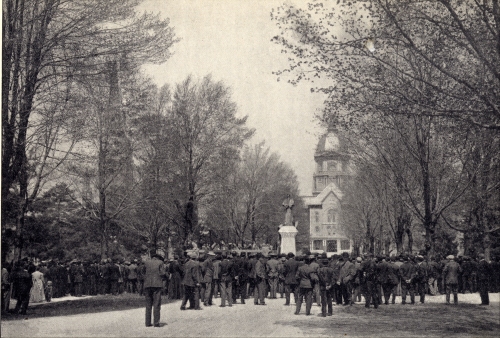
The long procession wended its way to the site of the statue which was as yet concealed with the Stars and Stripes which Father Sorin loved so much and the papal ensign. It was Father Cavanaugh’s privilege to speak at the unveiling.
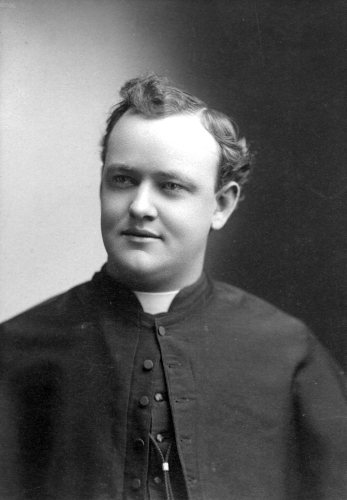
Father John W. Cavanaugh, President of Notre Dame, came forward, and with superb manner and in glorious voice spoke the words of an address that for classic beauty and eloquence reminds one of Lincoln’s Gettysburg Address, in part:
Threescore years and more have passed since a young missionary first looked in hope and affection on the wilderness where now blooms this beautiful garden. He had left the mellow civilization of France for a raw, pioneer country where one might travel for days almost without seeing the smoke curl up from a woodman’s chimney. Poor, untried, ignorant of the customs and language of the people, he and his brave Brothers looked smiling and unafraid into the face of privations and labor. Often he was carried half frozen from the sled in which he made his missionary journeys to the Indians and the scattered white men for one hundred and fifty miles in every direction; more than once the horses were unyoked from the plow and sold for debt. Once at least the students must have gone supperless to bed were it not that a passing stranger made an unexpected gift; once pestilence almost annihilated the Community; twice the hungry fire devoured the work of generations; a thousand times came terror and discouragement, but never once despair.
Rich only in the zeal of this fervent soul, strong only in the courage of his noble heart, he labored on, till today the work he directed is the pride of America and the glory of the Church. No man who needs a monument to commemorate his memory ought ever to have one; unless the story of a man’s achievements lives in the hearts of his fellowmen, no bronze, however high, can lift his name out of oblivion. Notre Dame is Father Sorin’s monument; but today a grateful people have demanded that the gracious features and the manly figure of this great priest should be preserved for generations that never looked on him in life. . . .
At the proper moment, Brother Charles pulled the cord that unveiled the statue, and Father Sorin in eight feet of bronze stood in the midst of those who did honor to his memory. “Perfect,” “matchless,” was the spontaneous cry of those who knew the venerable patriarch in life. The statue was afterward blessed, and the procession returned to the church. -- Excerpts from Notre Dame Scholastic Vol. 39, Pages 489-491.
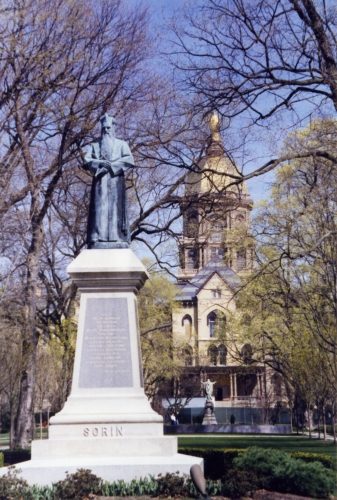
Historical Note: In December, in the midst of their plans for the double celebration Father John W. Cavanaugh, C.S.C. who had never had the opportunity of earning a doctorate, was honored by the University of Ottawa, Canada, by an honorary degree of Doctor of Divinity. It was a gracious gesture and one for which Father Cavanaugh was thankful. As he stood on the stage clothed in the brilliant scarlet of his doctor’s gown, he remarked: “Even my robes are blushing.”
The Very Rev. Dr. Emery spoke of the sympathy that existed between the sister universities, Ottawa and Notre Dame, and declared that the honor his Alma Mater was about to confer upon Father Cavanaugh was not a debt of gratitude but merely the acknowledgement of one. -- Notre Dame Scholastic, December 22, 1905, p. 226.
Compiled by Dorothy V. Corson from original accounts of the double celebrations which took place on May 3, 1906 and were recorded in the Notre Dame Scholastic Vol. 39 1905-1906 Pages 480-493.
<< back | The Spirit of Notre Dame | next >>